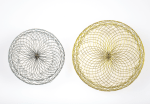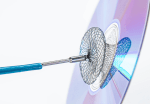This study analyzed 2,493 “real world” patients, 1,352 receiving the Evolut R/Pro, 675 the SAPIEN, 3,270 the Acurate Neo and 192 the Portico. Primary end point was all cause mortality and major adverse cardiovascular events (MACE) at 5 years. Populations were similar, with EuroSCORE 4.9%, and there were no significant differences in comorbidities or echocardiographic...
EuroPCR 2024 | SOLVE-TAVI: Self Expanding or Balloon Expandable Valves?
This was a randomized study with 447 patients carried out to compare the 5-year evolution of TAVR using Evolut R and SAPIEN 3, as well as general anesthesia vs. conscious sedation. Randomization was in two stages: first valve selection and later the anesthesia technique, that is, conscious sedation vs general anesthesia. The populations were similar....
Aortic Stenosis Progression Evolution
Aortic stenosis is an increasingly common valvulopathy because people are living longer now. A present, the main treatment consists of surgical (SAVR) or transcatheter aortic valve replacement. (TAVR). One of the main challenges of this disease is its progression. The European guidelines recommend Doppler echocardiograms every 2 to 3 years for mild cases, mildly calcified,...
Evolution of Leak in Left Atrial Appendage Closure
Atrial fibrillation is common in elderly people and is associated with a higher risk of ischemic stroke. Left atrial appendage occlusion (LAAO) is a valid strategy, especially in patients at high risk of bleeding. The presence of peridevice leak (PDL) has been linked to stroke, although some analyses, such as the PROTEC-AF Study, suggest that...
TAVR in Bicuspid Valves
Bicuspid aortic valve (BAV) disease affects 1%-2% of the population and manifests with severe aortic stenosis in the middle-aged. It characterizes for a very different anatomy with more calcification than the tricuspid aortic valve. At present, surgical aortic valve replacement (SAVR) is the first treatment indication. TAVR in this scenario has shown, in different studies,...
Acute Myocardial Infarction After TAVI: Retrospective Analysis of >200,000 Implants
Coronary artery disease is common among patients considered for transcatheter aortic valve implantation (TAVI). With the expansion of the indication for TAVI to a population with lower surgical risk, and therefore younger, there has been a gradual increase in the incidence of coronary events. However, there is limited data on treatment strategy and outcomes in...
12-Month Evolution of Edge-to-Edge Repair with PASCAL
Mitral regurgitation (MR) is the most frequent valve disease. Mitral transcatheter edge-to-edge repair (M-TEER) has been shown beneficial in high or prohibitive risk patients in cases of degenerative and functional MR. The PASCAL device has been shown safe and effective by the CLASP II, but we still need further research in clinical “real world” environments. ...
Single Antiplatelet Therapy Following Percutaneous Left Atrial Appendage Occlusion
Percutaneous left atrial appendage occlusion (LAAO) has surged as an effective alternative to treat patients with atrial fibrillation (AF) presenting counterindications for oral anticoagulants. However, the optimal antithrombotic treatment after LAAO is still debated, seeing as it should prevent device related thrombosis (DRT) while minimizing bleeding risk. The aim of this retrospective study carried out...
LpA: 30-Year Cardiovascular Followup in Primary Prevention Cohorts
For years, treating dyslipidemia mainly focused on reducing LDL cholesterol (LDL-C) with statins, which had shown benefits in reducing atherosclerotic cardiovascular disease (ASCVD). Lipoprotein(a) [Lp(a)] is a form of apoB-containing lipoprotein bound to a hydrophilic, highly glycosylated protein called apolipoprotein(a) [apo(a)]. Circulating levels of Lp(a) are genetically determined, and are hardly affected by eating habits...
ERCTO Registry: Chronic Total Occlusion Treatment Outcomes
Chronic total occlusion (CTO) affect up to 20% of patients undergoing angiographic diagnostic tests. During the last two decades, recanalization technique refinement, the development of specific devices and operator skill improvement have elevated procedural success rate up to 90%. However, there are still particular complications such as collateral perforation and access site complications. This is...








